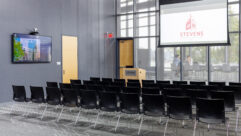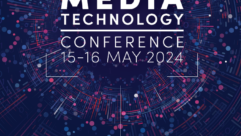
It’s not often that science and art meet the live event world. These very diverse fields came together at two unique events in New Jersey where invited guests and the public were treated to amazing interactive experiences.

WorldStage supported Nokia Bell Labs and Stevens Institute of Technology to supply technology and content integration for the First Shannon Conference on the Future of the Information Age on the Bell Labs campus in Murray Hill. They also worked with Nokia Bell Labs and innovative musician Beatie Wolfe’s on Wolfe’s performance at Propeller Fest, a new event in Hoboken dedicated to the intersection of technology and business.
Both events featured the new The Human Digital Orchestra(tm). In 2016 Bell Labs resurrected the Experiments in Art and Technology (E.A.T.) program and created the Human Digital Orchestra. It merges the motion of artists and the audience to create a multimedia experience with music, speech, and video dynamically reacting to the humans present.
“What distinguishes WorldStage is our willingness to reach outside traditional AV markets to work with scientists, artists and others who are exploring new ways to communicate and entertain audiences,” says WorldStage president Josh Weisberg. “We’re one of the few vendors capable of taking on projects like the Shannon Conference and Beatie Wolfe at Propeller Fest because we not only provide technology support but also make an emotional investment in the success of the events. It’s what we’re passionate about!”
Shannon Conference
The Shannon Conference marked the centennial of Claude Shannon, a Bell Labs scientist who devised The Theory of Information in 1948 – concepts which form the foundation of digital computing and digital transmission. The two-day conclave celebrated Shannon’s life and his profound impact on the world we live in today.
“The challenge for the Shannon Conference was that everything had to happen live,” says WorldStage assistant engineer Julian Chaves, a 2015 Stevens graduate. “The scientists at Bell Labs are used to working in a controlled environment. We had to take them out of their comfort zone into our world of live production where you only get one shot. It’s what we do day in, day out. The scientists were excited and proud when everything went off without a hitch!”
The Human Digital Orchestra made its debut performing “The Shannon Effect” in a big top tent. Bell Labs positioned multiple camera sensors above the stage and in the invited audience and provided a pianist, tap dancer, clarinetist and conductor with small accelerometers that tracked their movements. Those devices triggered audio, video and lighting cues during the orchestra’s performance.
“We were involved from the planning stage working with Stevens on how to create a control system interface with the engineers at Bell Labs,” says WorldStage chief engineer Barry Grossman. “We also supplied the video, audio and lighting equipment typical of a live theatrical production.”
Chaves designed the projection system for the event, which featured a main screen for the stage and projections on each side wall of the tent. Content included visuals preproduced by Chaves; real-time trace map representations of the performers in outline form; and RFscape, a real-time landscape of the WiFi signals from 500 cell phones during audience participation.
“We took the output of the data into our projection control system to create a fully immersive room with visuals and sound,” says Chaves. “Widget Designer allowed us to create a custom control interface so we could take in the Bell data and control the visuals, audio and lighting. A Pandoras Box media server processed all the visuals, a Yamaha CL5 console triggered the audio effects and a (ADD NAME) console triggered the lighting effects.” WorldStage furnished eight 10K projectors for the HD video feeds.
Propeller Fest
WorldStage also provided video control for Beatie Wolfe’s appearance at Propeller Fest. The London-based Wolfe performed with her Technology Jacket, which has waveforms for her songs woven into the fabric and NFC cards built into the jacket.
Wolfe opened with a storytelling piece explaining the functions of her jacket. Chaves edited preproduced content from Wolfe, which she triggered via a Bell Labs interface with the jacket. A Pandoras Box media server fed the visuals to a 20×10-foot Unilimin LED screen and two LED side screens.
Then Wolfe performed several songs whose visuals mixed clips from her music videos with stick-figure trace maps of the audience’s movements overlaid on live feeds of the crowd. “The more the audience saw how their interaction affected the visuals the more they moved around,” notes Chaves. “Another interaction made her drummer and bassist fade in and out on the side screens depending on how active the crowd was.”
During Wolfe’s set WorldStage controlled new OZO cameras developed by Nokia Technologies, the first virtual reality cameras that capture 360º spherical video and full 3D spatial audio. Her performance was intercut with live pans of the 360º view creating a fully immersive environment for the audience.
Wolfe’s show concluded with the visual display, The Tapestry. “Bell Labs wanted an artistic element that would be specific to Propeller Fest so they developed software duplicating the red and gold threads in her Technology Jacket, which were woven into the video in real-time during Beatie’s last song,” Chaves explains. “Her movements dictated the color of the thread being woven; we overlaid trace maps of her on the beautiful graphic tapestry.”










